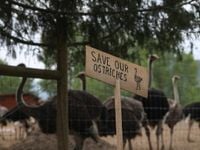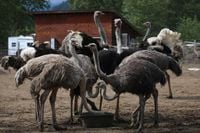On November 6, 2025, a grim and controversial chapter in Canadian animal agriculture unfolded at the Universal Ostrich Farm in Edgewood, British Columbia. More than 300 ostriches were killed by gunfire in a single, darkened enclosure over several hours, a process that animal welfare advocates and legal experts have since condemned as both cruel and unnecessary. The mass culling, carried out under the supervision of the Canadian Food Inspection Agency (CFIA), followed the Supreme Court of Canada’s refusal to hear the farm’s final appeal against a federal order to eradicate the flock after an outbreak of highly pathogenic avian influenza (H5N1).
The story behind this dramatic event is as complex as it is polarizing, revealing deep rifts in Canadian society over science, public health, and animal welfare. According to Animal Justice, Canada’s leading national animal law organization, the method used to kill the ostriches was “shocking.” In a formal complaint filed with the CFIA on November 12, the group argued that confining the ostriches together and shooting them in front of each other, especially in the dark, caused “abject terror and suffering.” As Animal Justice explained, “Ostriches are intelligent, social animals with particularly strong night-vision and killing them in an enclosed space, conscious and aware of their companions’ deaths by loud, repeated gunshots, would have undoubtedly caused abject terror and suffering.”
The organization claims that the CFIA’s actions likely violated both the federal Criminal Code, which prohibits causing animals unnecessary suffering, and British Columbia’s Prevention of Cruelty to Animals Act, which bans causing distress when killing animals except under reasonable and generally accepted practices. Camille Labchuk, a lawyer and executive director of Animal Justice, did not mince words: “The CFIA had nearly a year to plan for this killing, and yet the method they chose was shocking. Instead of prioritizing the welfare of these intelligent, sensitive animals, it appears the CFIA’s focus was on optics, hiding the slaughter from public view, rather than ensuring it was carried out in a humane and controlled way. Shooting hundreds of ostriches in full view of one another is a method that would have caused extreme fear and suffering, and it should never have been considered acceptable.”
The cull was not a sudden decision. It followed a lengthy legal and regulatory odyssey that began in late 2024, when an anonymous tip led CFIA officials to inspect the farm. They discovered dozens of dead ostriches, later confirmed to have succumbed to H5N1 avian flu. The infection was likely introduced after hundreds of wild ducks—known carriers of H5N1—landed on an open pond at the property. The subsequent federal court decision cited significant evidence of “deplorable biohazard conditions” at the farm, including wild birds and animals entering quarantine zones, decomposing carcasses scavenged by wildlife, and a lack of containment for staff and visitors moving through infected spaces.
Despite these findings, the farm’s owners challenged the cull order, arguing that the ostriches’ “genetic rarity” and potential relevance to disease research should override the stamping-out policy recommended by the World Organisation for Animal Health and enforced by the CFIA. Their submission was ultimately rejected due to insufficient supporting evidence. In May, the Federal Court determined that the CFIA’s cull order was reasonable and procedurally fair, a decision later upheld by the Federal Court of Appeal. The Supreme Court’s refusal to hear the farm’s appeal on November 6, 2025, cleared the way for the mass killing to proceed.
Yet, the controversy did not end there. The cull became a lightning rod for a diverse coalition of opponents, including fringe online media, former pandemic activists, and leaders of the 2022 trucker convoy, who saw the case as another example of government overreach and the erosion of individual rights. Prominent figures such as Tamara Lich and Maxime Bernier, leader of the People’s Party of Canada, lent their support to the farm’s cause. Even south of the border, U.S. Secretary of Health Robert Kennedy Jr. urged Canadian authorities to reconsider, citing unproven claims about the ostriches’ importance to vaccine and biologics research.
Disinformation campaigns and social media activism fanned the flames, with some alleging that the government’s actions constituted an attack on farmers’ freedoms and a dangerous overextension of bureaucratic power. According to The Globe and Mail, these dynamics closely mirrored the resistance to public health measures seen during the COVID-19 pandemic, when skepticism toward science and government interventions became deeply politicized. “The same influencers, the same arguments, the same divisiveness from the COVID era threaten public safety today,” the article noted, warning that such trends contribute to a growing distrust in science and an alarming disengagement from the common good.
For public health officials, the stakes were high. Unlike chickens or turkeys, ostriches can act as reservoirs for the HPAI virus and transmit it even when they show no symptoms. Laboratory analysis of the strain found at Universal Ostrich Farms revealed that it was a novel version of the virus, displaying enhanced pathogenicity and low-dose lethality in mice. It was also related to a strain that had previously infected a person at a poultry farm in Ohio. The CFIA, therefore, was obligated to apply the stamping-out policy to prevent the risk of viral spillover into human populations—a requirement not only of Canadian law but also of international trade agreements such as the Canada-United States-Mexico Agreement and the Canada-EU Comprehensive Economic and Trade Agreement. Noncompliance could have serious repercussions for Canadian agribusiness and the country’s standing in global markets.
Still, Animal Justice and other advocates maintain that public health imperatives do not excuse what they describe as “horrifying” methods. They point to the precedent set by the Whistler sled dog cull, where a court found that killing animals in view of one another constituted an aggravating feature in a criminal animal cruelty case. “While the courts confirmed the CFIA had legal authority to act in this circumstance, that does not shield them from scrutiny, especially considering the horrifying method the agency chose to kill these animals. The CFIA does not get a free pass from complying with animal protection laws simply because it was carrying out a lawful order,” Labchuk emphasized. “The CFIA must restore public trust by conducting a thorough review of what happened and taking concrete steps to improve its approach to animal welfare.”
Before the cull, Animal Justice had urged the CFIA to halt the planned killing and conduct renewed testing to determine whether the ostriches still carried avian influenza. Independent infectious disease experts suggested that further testing could have revealed the birds’ current health status, potentially making the mass killing unnecessary. But these calls went unheeded as the cull moved forward under judicial and regulatory mandate.
The ostrich cull in Edgewood has become a flashpoint for a host of broader issues: the politicization of science, the spread of disinformation, the tension between public health and individual rights, and the urgent need for transparent, humane policies in animal agriculture. As Canadians grapple with the aftermath, the episode serves as both a cautionary tale and a call to action for better governance, clearer communication, and renewed trust in the institutions charged with safeguarding public health and animal welfare.





